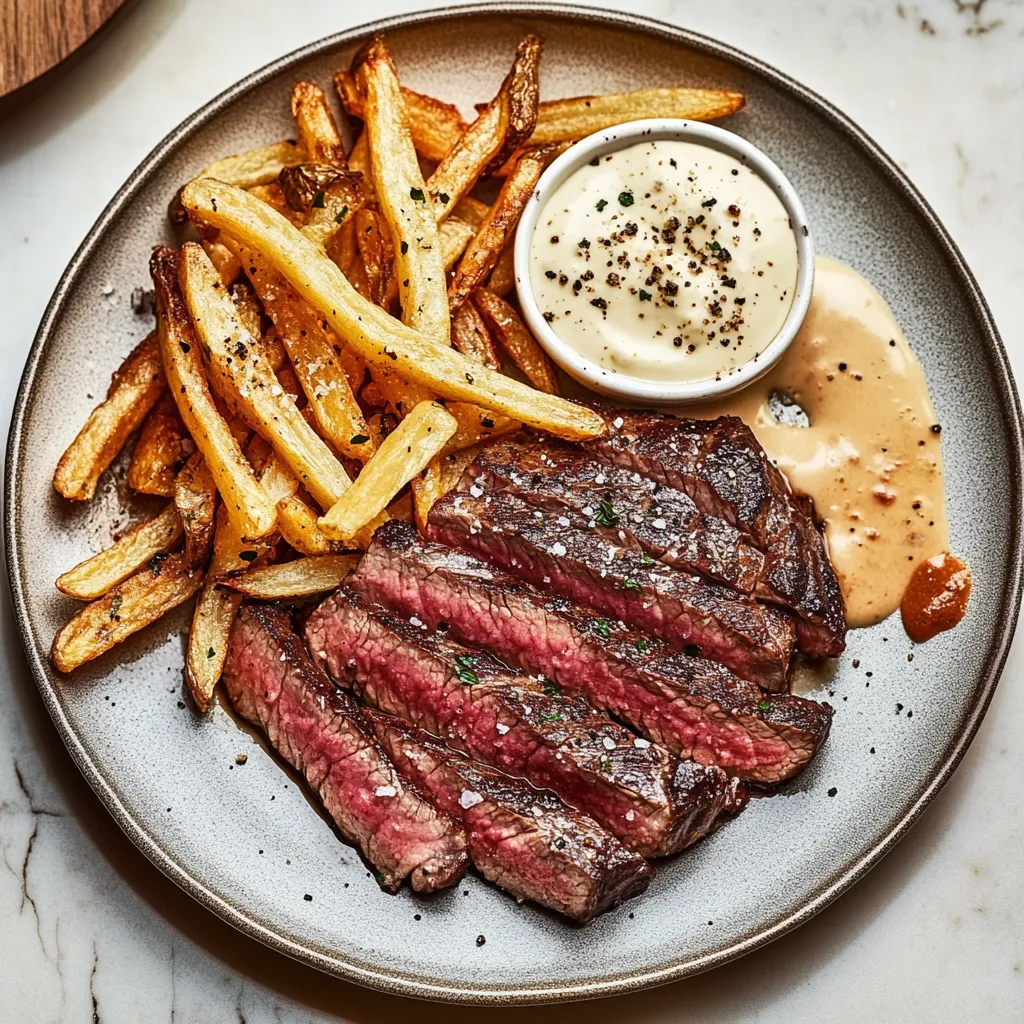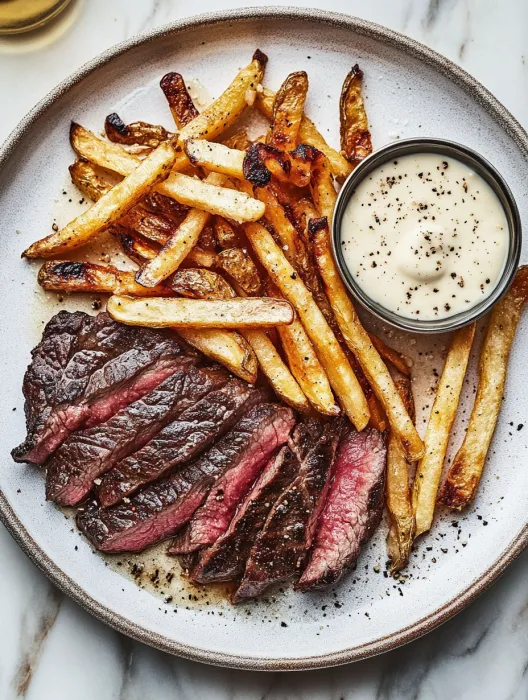 Save
Save
This classic steak frites recipe brings the beloved French bistro staple right to your dinner table. The combination of perfectly cooked ribeye steak and twice-fried crispy potatoes creates a comforting yet impressive meal that feels special without requiring complicated techniques.
I first made this recipe when celebrating my anniversary at home instead of going out, and now it has become our special occasion tradition. The look on my partner's face when I serve those perfectly golden fries alongside a juicy steak is priceless every time.
Ingredients
- Large russet potatoes these starchy potatoes create the perfect crispy exterior and fluffy interior for authentic frites
- Refined peanut oil crucial for high-heat frying without imparting unwanted flavors look for a high smoke point
- Ribeye steak the marbling in this cut ensures juicy tender results even with simple preparation
- Kosher salt coarser than table salt provides better control over seasoning
- Extra virgin olive oil adds flavor when searing the steak
- Unsalted butter finishing the steak with butter creates a luxurious richness
- Freshly cracked black pepper always crack pepper fresh for maximum flavor
- Garlic aioli the creamy garlicky sauce brings everything together
Step-by-Step Instructions
- Prepare the Potatoes
- Soak peeled and cut potatoes in ice water for 15 minutes to remove excess starch. This step is crucial for achieving crispy fries. Make sure to cut your potatoes as uniformly as possible for even cooking. After soaking, thoroughly pat them dry as moisture will cause dangerous oil splatters.
- First Fry
- Heat peanut oil to exactly 300°F using a thermometer for precision. This initial fry at a lower temperature cooks the potatoes through without browning them. Work in small batches to maintain oil temperature and ensure even cooking. The potatoes should look pale and slightly softened when removed.
- Cook the Steak
- Heat a large skillet until very hot. Season the room temperature steak generously with salt on all sides. Add oil to the pan and wait until it just begins to smoke before adding the steak. Resist the urge to move the steak around let it develop a beautiful crust. Flip only once and cook to your preferred doneness. Resting with butter on top allows the juices to redistribute.
- Second Fry
- Increase oil temperature to exactly 350°F. This higher temperature final fry creates the crispy golden exterior without overcooking the inside. Again working in batches prevents overcrowding and dropping the oil temperature. The fries should be deeply golden and audibly crispy when done.
- Serve Immediately
- Slice the rested steak against the grain for maximum tenderness. Arrange on plates with hot fries and garlic aioli. The contrast between the crispy salty fries and the rich juicy steak creates the perfect bite especially when dipped in garlicky aioli.

The first time I made this recipe, I accidentally skipped the initial fry and went straight to the higher temperature. The results were disappointing fries that were brown on the outside but undercooked inside. The double-fry method seems like extra work but creates that perfect frite texture that makes this dish truly special.
The Secret to Perfect Frites
The ice water soak is crucial for removing excess starch from the potatoes. This step might seem unnecessary but it makes all the difference in achieving that crispy exterior and fluffy interior that defines proper French frites. After soaking, ensure you thoroughly dry the potatoes with paper towels or a clean kitchen towel to prevent dangerous oil splatters. The double-frying method might seem fussy but is actually the restaurant secret to achieving that distinctive texture.
Choosing the Right Steak
While this recipe calls for ribeye, you can substitute with other well-marbled cuts like strip steak or even a thick flank steak if properly prepared. The key is having enough fat marbling throughout the meat to keep it juicy when cooked to medium-rare. If using a leaner cut, consider tenderizing it first or marinating briefly. Always allow your steak to come to room temperature before cooking for the most even results and a better sear.
Elevate Your Aioli
The garlic aioli served alongside this dish can be store-bought for convenience, but homemade takes the meal to another level. Make your own by whisking together 1/2 cup mayonnaise, 2 minced garlic cloves, 1 tablespoon lemon juice, and a pinch of salt. For variations, consider adding herbs like chopped parsley or tarragon, or even a dash of truffle oil for an upscale twist. The creamy garlic sauce complements both the steak and frites perfectly.
Serving Suggestions
Steak frites traditionally stands alone as a complete meal, but a simple green salad dressed with a bright vinaigrette makes an excellent accompaniment to cut through the richness. For wine pairing, choose a bold red like Cabernet Sauvignon or Malbec that can stand up to the rich flavors. Serve the frites in a paper cone or small metal basket for an authentic bistro presentation, with the sliced steak arranged alongside rather than underneath to maintain crispiness.

Recipe FAQs
- → Why do you soak the potatoes in ice water?
Soaking the potatoes in ice water removes excess starch, which helps achieve crispier frites. The cold water also prevents the potatoes from oxidizing and turning brown before cooking.
- → What's the benefit of double-frying the potatoes?
Double-frying creates the perfect frites texture. The first fry at a lower temperature (300°F) cooks the potato through, while the second fry at a higher temperature (350°F) creates the crispy golden exterior while maintaining a fluffy interior.
- → How can I tell when my steak is done without a thermometer?
Without a thermometer, you can use the finger test. Touch your thumb to your index finger and press the fleshy part below your thumb - that's how medium-rare feels. For medium, touch your middle finger to your thumb. The steak should feel similar when pressed.
- → Why should steak rest before slicing?
Resting allows the juices to redistribute throughout the meat. If you slice immediately after cooking, those flavorful juices will run out onto the cutting board instead of remaining in the meat, resulting in a drier steak.
- → Why slice steak against the grain?
Slicing against the grain (perpendicular to the muscle fibers) shortens these tough fibers, making each bite more tender and easier to chew. This is especially important for cuts like ribeye.
- → Can I use a different type of oil for frying?
Yes, while refined peanut oil is recommended for its high smoke point and neutral flavor, you can substitute other high smoke point oils like vegetable, canola, or grapeseed oil. Avoid olive oil, which has too low a smoke point for deep frying.
